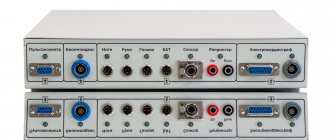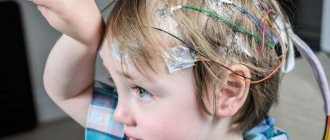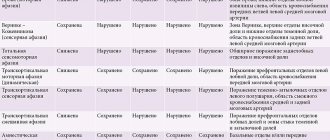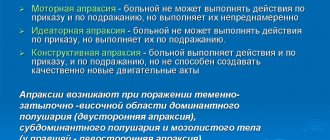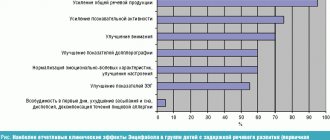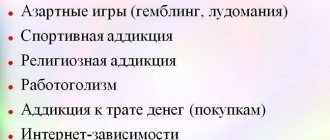Restorative learning for different forms of aphasia
The article discusses the program, specific steps and methods of remedial training for the following forms of aphasia: efferent motor aphasia, dynamic aphasia, afferent motor, sensory, acoustic-mnestic, semantic and amnestic aphasia.
Depending on the form of aphasia, the severity of the defect, the stage of the disease, and the individual characteristics of speech disorders, the integrated use of the considered methods for restoring oral and written speech will help a person adapt to life with this acquired disorder. Restorative learning is based on one of the most important properties of the brain—the ability to compensate. To restore impaired functions, both direct and bypass compensatory mechanisms are used.
Direct disinhibitory methods of work are mainly used in the individual stage of the disease and are designed to activate reserve intrafunctional capabilities. Bypass methods imply compensation based on the restructuring of the most impaired function due to cross-functional restructuring. In other words, the restorative effect is achieved through the introduction of new, “workaround” ways of performing certain speech or gnostic-praxic operations.
It is also necessary to strictly take into account the characteristics of each specific case of the disease.
Rehabilitation training is carried out according to a special, pre-developed program. The program should include certain tasks and corresponding work methods, differentiated depending on the form of aphasia (apraxia, agnosia), severity of the defect, stage of the disease, individual characteristics of speech disorders, but rehabilitation work in it should be carried out on all aspects of the impaired function, and not only over those who suffered primarily.
In addition, rehabilitation training should primarily be aimed at restoring the communication abilities of patients. It is necessary to involve the patient in communication not only in classes, but also in the family, as well as in public places.
I can almost catch what you're saying
In acoustic-mnestic aphasia, symptoms manifest themselves primarily in a weak, incomplete understanding of the speech of the interlocutor. It is difficult for the patient to grasp the context of the story, the general meaning of the statements addressed to him. When trying to speak independently, he encounters the following difficulties:
- The patient remembers what this or that object is needed for and what its characteristics are, but cannot pronounce its name.
- The speaker may repeat the same word repeatedly, as well as take unreasonably long breaks between words.
- The patient realizes that his oral speech is far from perfect. He tries to make up for the lack of words with intonations, gestures, and facial expressions.
Throughout the day, the child’s mood changes repeatedly. Periodically, he is overcome by anxiety, which further narrows the scope of auditory perception. The patient’s RAM is overloaded: although information enters the brain, it does not have time to process it in a timely manner.
MOTOR APHASIA OF AFFERENT TYPE
Stage of severe disorders
1. Overcoming disorders of understanding situational and everyday speech:
- display of pictures and real images of the most commonly used objects and simple actions by their names, categorical and other characteristics. For example: “Show a table, a cup, a dog, etc.”, “Show pieces of furniture, clothing, transport, etc.” “Show someone who flies, who talks, who sings, who has a tail, etc.”
— classification of words by topic (for example: “Clothing”, “Furniture”, etc.) based on a subject picture;
— answers with an affirmative or negative gesture to simple situational questions. For example, “Is it winter now, summer..?”; "You live in Moscow?" and etc.
2. Disinhibition of the pronunciation side of speech:
- conjugate, reflected and independent pronunciation of automated speech series (ordinal counting, days of the week, months in order, singing with words, ending proverbs and phrases with a “hard” context), modeling situations that stimulate the pronunciation of onomatopoeic pronouns (“ah!” “oh” !" and so on.);
- conjugate and reflected pronunciation of simple words and phrases;
- inhibition of the speech embolus by introducing it into a word (ta, ta..-Tata, so), or into a phrase (ma..ma-mama...; this is mom).
3. Stimulating simple communicative types of speech:
— answers to questions in one or two words in a simple situational dialogue;
— modeling situations that contribute to the evocation of communicatively significant words (yes, no, want, will, etc.);
— answers to situational questions and composing simple phrases using a pictogram and a gesture accompanied by the pronunciation of simple words and phrases.
4. Stimulating global reading and writing:
— laying out captions under pictures (subject and subject);
- writing the most common words-ideograms, copying simple texts;
— conjugate reading of simple dialogues.
Moderate stage of disorders
1. Overcoming disorders of the pronunciation side of speech:
- isolating sounds from words;
— automation of individual articles in words with different syllabic structures;
— overcoming literal paraphasias by selecting first discrete and then gradually converging sounds in articulation.
2. Restoration and correction of phrasal speech:
- composing phrases based on a plot picture: from simple models (subject-predicate, subject-predicate-object) to more complex ones, including objects with prepositions, negative words, etc.;
- composing phrases on questions, on key words;
- exteriorization of grammatical-semantic connections of the predicate: “who?”, “why?”, “when?”, “where?” etc.;
— filling in gaps in a phrase with a grammatical change in a word;
— detailed answers to questions;
- compiling stories based on a series of plot pictures;
- retelling texts based on questions.
3. Work on the semantics of the word:
— development of generalized concepts;
- semantic play on words (subject and verbal vocabulary) by including them in various semantic contexts;
— filling in the gaps in a phrase;
- completing sentences with different words that are appropriate in meaning;
- selection of antonyms, synonyms.
4. Restoration of analytical-synthetic writing and reading:
- the sound-letter composition of the word, its analysis (one-two-three-syllable words) based on diagrams that convey the syllabic and sound-letter structure of the word, a gradual reduction in the number of external supports;
- filling in missing letters and syllables in words;
- copying words, phrases and small texts with an emphasis on self-control and independent error correction;>
- reading and writing from dictation of words with a gradually more complex sound structure, simple phrases, as well as individual syllables and letters;
- filling in missing words in texts when reading and writing, practiced in oral speech.
Stage of mild disorders
1. Further correction of the pronunciation aspect of speech:
— clarification with articles of individual sounds, especially affricates and diphthongs;
— differentiation of acoustic and kinesthetic images that are similar in articulation of sounds in order to eliminate literal paraphasias;
- practicing the purity of pronunciation of individual sounds in a sound stream, in phrases, with a combination of consonant sounds, in tongue twisters, etc.
2. Formation of detailed speech, complicated in semantic and syntactic structure:
- filling in the missing main sentence, as well as a subordinate sentence or subordinating conjunction in a complex sentence;
- answering questions with complex sentences;
- retelling texts without relying on questions;
— drawing up detailed plans for texts;
— preparation of thematic messages (short reports);
- speech improvisations on a given topic.
3. Further work to restore the semantic structure of the word:
- interpretation of individual words, mainly with abstract meaning;
— explanation of homonyms, metaphors, proverbs, phraseological units.
4. Work on understanding complex logical and grammatical figures of speech:
— execution of instructions, including logical and grammatical phrases;
— introduction of additional words, pictures, questions that facilitate the perception of complex speech structures.
5. Further restoration of reading and writing:
- reading and retelling expanded texts;
- dictations;
— written presentation of texts;
— writing letters, greeting cards, etc.;
- essays on a given topic.
1) Restoring the “articuleme-phoneme” connection
- writing letters corresponding to the names of sounds in expressive speech, reading these letters immediately after writing;
- isolating the first sound from simple words, fixing attention on the articulatory, acoustic, and then graphic image of this sound; independent selection of words for this sound and writing them;
- writing practiced sounds and syllables under dictation;
— identification of letters in different fonts;
— finding given letters in various texts (underlining, writing out).
2) Restoring the ability to sound-letter analysis of the composition of a word:
- dividing words into syllables, syllables into letters (sounds) based on various graphic schemes;
- highlighting any sound in a word;
- recalculation and listing of words by letter (orally);
- filling in gaps in words;
- writing words from letters given separately.
3) Restoring the skill of detailed written speech:
- writing words of different sound structures with and without support from an object picture: a) under dictation, b) when naming an object or action;
- writing proposals: a) from memory, b) from dictation, c) in the form of a written statement based on a plot picture for the purpose of communication with others;
- written statements and essays.
Prevention of violations
Preventive measures are aimed at the primary prevention of diseases that can lead to speech disorders. Neurologists make a number of general recommendations:
- use protective helmets during professional activities and some sports;
- if you have diseases of the internal organs, for example, diabetes mellitus or atherosclerosis, promptly seek medical help and follow the instructions of your doctor;
- follow the principles of a healthy diet: give up fast food, fried or smoked foods, add fruits, vegetables, lean meat and other healthy foods to your diet;
- regularly engage in sports - cardio training and exercises in the gym;
- Avoid drinking alcohol and smoking.
If you experience difficulty finding words or other symptoms, you should immediately seek medical help.
MOTOR APHASIA OF EFFERENT TYPE
Stage of severe disorders
The recovery program is the same as for afferent motor aphasia.
Moderate stage of disorders
1. Overcoming disorders of the pronunciation side of speech:
- development of articulatory switches within a syllable:
with vowels contrasting in articulation pattern (“a” – “u”, etc.); with various vowels, including soft ones; in syllables, for example,
M A A S T R E C E P T
- development of articulatory switching within a word: merging syllables into words with a simple, and later with a complex sound structure (for example, recipe, etc.);
- exteriorization of the sound-rhythmic side of the word, dividing words into syllables, highlighting the stress in the word, reproducing the outline of the word in the voice, selecting words with an identical sound-rhythmic structure, rhythmic pronunciation of words and phrases with the use of external supports - tapping, clapping, etc. , capturing various consonances, including the selection of rhyming words.
2. Restoration of phrasal speech:
— overcoming agrammatism at the level of the syntactic scheme of a phrase: composing “core” phrases of models like S (subject) + P (predicate); S+P+O (object) with the involvement of external supports-chips and their gradual “collapse”; highlighting the predicative center of the phrase; exteriorization of its semantic connections;
— overcoming agrammatism at the formal grammatical level: catching grammatical distortions—inflectional, prepositional, etc. in order to revive the sense of language; differentiation of singular and plural meanings, generic meanings, meanings of the present, past and future tenses of the verb; filling in missing grammatical elements in words; composing phrases based on plot pictures; answering questions with a simple phrase, grammatically formatted; retelling a simple text; stimulation to use incentive and interrogative sentences, various prepositional structures.
Stage of mild disorders
The program is the same as for the corresponding stage of afferent motor aphasia.
When restoring written speech in patients with motor aphasia of the efferent type, as a rule, the independent task of developing the “articulome-grapheme” connection is not highlighted.
The emphasis is on:
1. Restoring the ability to analyze the sound-rhythmic side of a word:
— differentiation of words by length and syllabic composition;
- highlighting the stressed syllable;
- selection of words identical in sound-rhythmic structure;
- highlighting identical elements in words - syllables, morphemes and, in particular, endings (underlining them, writing them out, etc.).
2. Restoring the ability to sound-letter analysis of the composition of a word.
3. Restoring the skill of merging letters into syllables, syllables into words.
4. Restoring the skill of detailed written speech (specific teaching methods - see the program for restoring learning for afferent motor aphasia - paragraphs 2,3,4).
Children will return to normal faster
You should not demand excellent performance in school from your child immediately after overcoming the illness. Even after complete restoration of communication skills, a patient with aphasia may find it difficult to assimilate new information.
The good news is this: in acoustic-mnestic aphasia, the central mechanism does not destroy the brain of young people as significantly as in older people. With an integrated approach that combines drug treatment with physical exercise and other types of restorative therapies, the period of complete recovery is on average five years. However, among young patients in good health, cases of accelerated and sudden relief from the disease are sometimes observed. In addition, in adults, recovery usually remains partial, but in children there is a high chance of full recovery of brain function.
DYNAMIC APHASAIA
Stage of severe disorders
1. Increasing the level of general activity of the patient, overcoming speech inactivity, organizing voluntary attention:
- performing various types of non-verbal activities (drawing, modeling, etc.);
— assessment of distorted images, words, phrases, etc.;
- situational, emotionally significant dialogue for the patient;
- listening to plot texts and answering questions about them in the form of affirmative-negative gestures or words “yes”, “no”.
2. Stimulating simple types of communicative speech:
— automation in dialogical speech of communicatively significant words: “yes”, “no”, “can”, “want”, “will”, “must”, etc.;
— automation of individual cliches of communicative, incentive and interrogative speech: “give”, “come here”, “who’s there?”, “hush!” etc.
3. Overcoming speech programming disorders:
- stimulation of answers to questions with a gradual decrease in the answer of words borrowed from the question;
- constructing phrases of the simplest syntactic models based on chips and a simple plot picture;
- performing simple grammatical transformations to change words that make up a phrase, but are presented in nominative forms;
- laying out a series of sequential pictures according to the plot contained in them.
4. Overcoming grammatical structuring disorders
5. Stimulating written speech:
— laying out captions under pictures;
- reading ideogram words and phrases.
Moderate stage of disorders
1. Restoration of communicative phrasal speech:
— construction of a simple phrase;
- composing phrases based on a plot picture using the chip method and gradually “collapsing” the number of external supports;
- compiling a story based on a series of sequential pictures;
— detailed answers to questions in the dialogue;
- compiling simple dialogues like speech sketches: “In a store” - a dialogue between a buyer and a seller, “In a savings bank”, “In an atelier”, etc.
2. Overcoming perseverations in independent oral and written statements:
- display of objects in pictures and in the room, parts of the body (in random order, by individual names and by series of names);
- ending phrases with different words;
- selection of words of given categories and in given quantities, for example, two words related to the topic “Clothing” and one word related to the topic “Tableware”, etc.;
- writing numbers and letters broken down (from dictation);
- writing from dictation of words and phrases that contribute to the development of semantic and motor switching;
— elements of sound-letter analysis of the composition of a word: folding simple words from letters of a split alphabet;
- filling in gaps in words;
- writing simple words from memory and dictation.
Stage of mild disorders
1. Restoration of spontaneous communicative phrasal speech:
- extensive dialogue on various topics;
- constructing phrases based on a plot picture with a gradual decrease in the number of external supports;
— automation of phrases of certain syntactic models in spontaneous speech;
- accumulation of a verbal dictionary and “revitalization” of the semantic connections behind the predicate (with the help of questions posed to it);
- reading and retelling texts;
- “role-playing conversations”, playing out a certain situation;
- “speech improvisations” on a given topic;
- detailed presentations of texts, essays;
- drafting greeting cards, letters, etc.
Straightforward letters, jumbled words
The main mechanism of acoustic-mnestic aphasia is the loss of the sensitive basis of a word due to a decrease in the formation of visual function. Simply put, words do not create visual associations and emotional reinforcement for a child. The patient does not connect together the picture and the set of letters or sounds behind it.
In acoustic-mnestic aphasia, the central defect also affects the ability to communicate in writing. If a child has already learned to read and write confidently before developing the disease, he will retain these skills. However, calligraphy will be automatic, and the syntax and word order in sentences will often be broken. When the text is dictated to the patient, the same expressions will have to be repeated repeatedly.
Sometimes the structure of a speech defect in acoustic-mnestic aphasia extends to the ability to perform arithmetic calculations. A child who already knows how to add, subtract, multiply and divide will not lose these skills - but will have difficulty remembering several numbers at once.
SENSORY APHASIA
Stage of severe disorders
1. Accumulation of everyday passive vocabulary:
— display of pictures depicting objects and actions by their names, functional, classification and other characteristics
— display of pictures depicting objects belonging to certain categories (“clothing”, “dishes”, “furniture”, etc.);
- showing body parts in the picture and in yourself;
- choosing the correct name of the object and action among the correct and conflicting designations based on the picture.
2. Stimulation of understanding of situational phrasal speech:
- answering questions with words “yes”, “no”, affirmative or negative gesture;>
- following simple oral instructions;
— capturing semantic distortions in simple phrases deformed in meaning.
3. Preparation for restoration of written speech:
— laying out captions for subject and simple plot pictures;
— answers to questions in a simple dialogue based on visual perception of the text of the question and answer;
- writing words, syllables and letters from memory;
- “voiced reading” of individual letters, syllables and words (the patient reads “to himself”, and the teacher reads out loud);
- development of the “phoneme-grapheme” connection by selecting a given letter and syllable by name, writing letters and syllables under dictation.
Moderate stage of disorders
1. Restoration of phonemic hearing:
- differentiation of words that differ in length and rhythmic structure;
- highlighting the same 1st sound in words of different lengths and rhythmic structures, for example: “house”, “sofa”, etc.;
- highlighting different 1st sounds in words with the same rhythmic structure, for example, “work”, “care”, “gate”, etc.;
- differentiation of words that are similar in length and rhythmic structure with disjunctive and oppositional phonemes by identifying differentiated phonemes, filling in gaps in words and phrases; capturing semantic distortions in a phrase; answers to questions containing words with oppositional phonemes; reading texts with these words.
2. Restoring understanding of the meaning of a word:
— development of generalized concepts by classifying words into categories; selection of a generalizing word for groups of words belonging to one or another category;
— filling in gaps in phrases;
- selection of definitions for words.
3. Overcoming oral speech disorders:
— “imposing a framework” on a statement by composing sentences from a given number of words (instructions: “Make a sentence of 3 words!”, etc.);
— clarification of the lexical and phonetic composition of the phrase using the analysis of verbal and literal paraphasias admitted by the patient;
— elimination of elements of agrammatism using exercises to “revitalize” the sense of language, as well as analysis of grammatical distortions.
4. Restoration of written speech:
- strengthening the “phoneme-grapheme” connection by reading and writing letters under dictation;
— various types of sound-letter analysis of the composition of a word with a gradual “collapse” of external supports;
- writing from dictation of words and simple phrases;
- reading words and phrases, as well as simple texts, followed by answers to questions;
- independent writing of words and phrases from pictures or written dialogue.
Stage of mild disorders
1. Restoring understanding of extended speech:
— answers to questions in an expanded, non-situational dialogue;
- listening to texts and answering questions about them;
— capturing distortions in deformed compound and complex sentences;
— understanding of logical and grammatical figures of speech;
— implementation of oral instructions in the form of logical and grammatical figures of speech.
2. Further work to restore the semantic structure of the word:
- selection of synonyms as homogeneous members of a sentence and out of context;
- work on homonyms, antonyms, phraseological units.
3. Correction of oral speech:
— restoration of the self-control function by fixing the patient’s attention on his mistakes;
- compiling stories based on a series of plot pictures;
- retelling texts according to plan and without plan;
— drawing up plans for texts;
- composing speech improvisations on a given topic;
— speech sketches with elements of “role-playing games”.
4. Further restoration of reading and writing:
— reading expanded texts, various fonts;
- dictations;
- written statements;
- written essays;
- mastering samples of congratulatory letters, business notes, etc.
Treatment approaches
Effective therapy is based on eliminating the immediate cause of the development of speech disorder. If a tumor lesion or intracranial hematoma is detected, treatment is carried out with neurosurgery, radiation or chemotherapy. Neuroinfections are eliminated using antifungal, antibacterial or antiviral drugs. Strokes are subject to thrombolytic or hemostatic treatment.
Correction of speech disorders is based on:
- Regular speech therapy sessions
They are carried out to increase the volume of auditory-verbal memory. They must be started immediately after the onset of the disease, without delaying a visit to a speech therapist for the rehabilitation period. Initially, exercises with visual perception of an object are used, which makes them easier to remember. Next, the specialist complicates the lessons - the patient writes simple dictations by ear, learns fragments of sentences, word chains, songs and poems. To improve expressive speech, active work is being carried out to clarify the meaning of words and systematize them into separate groups.
In parallel with the treatment of the main pathology, rehabilitation measures begin with the patient. An important part of therapy is communication with medical staff, speech therapist and loved ones. As a result of constant verbal contact and speech therapy exercises, auditory-verbal memory is restored. In addition, patients are advised to exercise therapy, massage and visit a psychotherapist.
ACOUSTIC-MNESTIC APHASIA
Stage of disorders of moderate and mild severity
1. Expanding the scope of auditory perception:
— display of objects (real and in pictures) by name, presented in pairs, triplets, etc.;
- showing body parts according to the same principle;
— implementation of 2-3-level oral instructions;
— answers to detailed questions, complicated by syntactic structure;
- listening to texts consisting of several sentences and answering questions about the content of the texts;
- writing from dictation with a gradual increase in phrases;
- reading gradually increasing phrases, followed by reproduction (from memory) of each of the sentences and the entire set as a whole.
2. Overcoming weakness of auditory-speech traces:
- repetition from memory of read letters, words, phrases with a gradual increase in the time interval between reading and reproduction, as well as filling the pause with some other type of activity;
— memorizing short poems and prose texts;
— repeated display of objects and pictures after 5-10 seconds, after 1 minute. after the first presentation;
- reading texts with time-delayed retelling (after 10 minutes, 30 minutes, the next day, etc.);
- composing orally sentences using reference words perceived visually;
- listing words by letter with a gradually more complex sound structure, and gradually moving away from the written example of these words.
3. Overcoming naming difficulties:
- analysis of visual images and independent drawing of objects denoted by name words;
- semantic play in contexts of various types of words denoting objects, actions and attributes of objects;
— classification of words with independent finding of a generalizing word;
— exercises on the interpretation of words with concrete, abstract and figurative meaning.
4. Organization of a detailed statement:
- compiling a story based on a series of plot pictures;
- retelling of texts, first according to a detailed plan, then according to a condensed plan, then without a plan;
- extensive dialogues on non-situational topics (professional, social, etc.); practicing samples of communicative and narrative writing (greeting cards, letters, statements, essays on a given topic, etc.).
MRI and pictures with objects
If the patient has the above-described structure of the defect in acoustic-mnestic aphasia, he needs to visit a speech therapist and neurologist. A speech therapist examines speech aspects of disorders of higher cortical functions. The neurologist will focus on hemitype sensory impairment (that is, only on one half of the body) and hemiparesis (that is, a decrease in muscle strength on the same (or another) half of the body).
Diagnosis is complicated by the fact that with a mildly expressed disease, the child’s speech seems normal - after all, pauses to select words are typical for children. To identify problems, the doctor will ask the patient to name the object shown in the picture or to guess the object from its verbal description.
To identify swelling of brain structures, hemorrhages or tumors, the patient may be referred for magnetic resonance imaging, computed tomography, ultrasound of cerebral vessels, or angiography. It is necessary to study hemodynamics - that is, to find out whether there is sufficient blood flow to the nerve cells, and to analyze the activity of blood flow in the cerebral cortex.
SEMANTIC APHASIA
Stage of disorders of moderate and mild severity
1. Overcoming spatial apractognosia:
— a schematic representation of the spatial relationships of objects;
- image of the plan of the path, room, etc.;
- design according to a model, according to a verbal task;
— work with a geographical map, hours.
2. Restoring the ability to understand words with spatial meaning (prepositions, adverbs, verbs with “movement” prefixes, etc.):
— a visual representation of simple spatial situations denoted by prepositions and other parts of speech;
— filling in missing “spatial” elements in words and phrases;
- composing phrases with words that have spatial
3. Construction of complex sentences:
— clarification of the meanings of subordinating conjunctions;
— filling in missing main and subordinate clauses;
- composing sentences with given conjunctions.
4. Restoring the ability to understand logical and grammatical situations:
- a picture depiction of the plot of the structure;
- the introduction of additional words that provide semantic redundancy (“my brother’s father”, “a letter from a beloved friend”, etc.);
— introduction of logical-grammatical constructions into a detailed semantic context;
- presenting designs in writing and then orally.
5. Work on an extended statement:
- presentations, essays;
— improvisation on a given topic;
- interpretation of words with complex semantic structure...
Article from the site: wapref.ru/referat_qasyfsujgpolyfsaty.html
Read also
Intracranial hypertension on MRI
Intracranial hypertension is an increase in intracranial pressure.
Normal intracranial pressure is 15 mm Hg. When blood pressure doubles, a stroke occurs. At a pressure of 50 mm Hg, the patient can... Read more
Carpal tunnel syndrome
Clinical manifestation of carpal tunnel syndrome This disorder occurs in the median nerve. The causes are tenosynovitis of the flexor tendon in the hands, acute articular rheumatism, pregnancy...
More details
Rehabilitation
Restoration of the body after diseases of the central and peripheral nervous system, operations on the brain and spinal cord, conditions after removal of the mammary gland due to a tumor, consequences...
More details
Polyneuropathy
Diabetic polyneuropathy is a pressing problem for patients with diabetes. Diabetic polyneuropathy is a serious complication of diabetes mellitus. The incidence of polyneuropathy is 26-50%...
More details
Chiari malformation
What is Chiari Malformation? Chiari malformation (formerly Arnold-Chiari malformation) is a congenital defect of brain development that involves the dislocation of the cerebellar tonsils into the spinal canal through the large…
More details
Causes
Amnestic aphasia is usually observed when the white matter is damaged at the junction of the parietal, occipital and temporal parts of the left or right hemisphere of the brain. It is important to note that the disease does not appear on the affected side, but on the opposite side. In left-handers, the right hemisphere is damaged, and in right-handers, the left. The main etiological reasons are the following factors:
- Traumatic damage to the above-described areas of the brain. Most often this occurs during road traffic accidents and blunt blows to the temporal region of the head with a heavy object. In this case, a rupture of axonal connections of the white matter of the brain of a traumatic nature may form.
- Surgical interventions on brain structures. Damage to neighboring brain structures cannot be ruled out, since anatomically all zones and regions of the brain are closely connected.
- Infectious and inflammatory diseases such as meningitis, encephalitis and brain abscess. Infectious diseases can be of viral or bacterial etiology and often lead to generalized brain damage.
- Neoplasms of a benign or malignant nature.
- Acute and chronic cerebrovascular accidents causing stroke, thrombosis of cerebral vessels or discirculatory encephalopathy.
- Acute intoxication of the body, especially with neurotoxic poisons, or as a result of an overdose of certain medications.
- Separately, lesions of nervous tissue are distinguished in acute renal or liver failure. In this form, metabolic and breakdown products are not removed from the body in a timely manner and lead first to dysfunctional disorders and then to organic damage to brain tissue.
- Mental illnesses.
- Alzheimer's disease and Pick's disease. In Alzheimer's disease, a combination of sensory aphasia with amnestic aphasia is often characteristic, and in Pick's disease, a combination with motor aphasia is more often observed.
There are several risk groups for amnestic aphasia:
- Genetic predisposition. If there are relatives in the family with similar diseases, then the hereditary history is burdened and significantly increases the risk of aphasia for the reasons described above.
- Elderly and senile age. Common extragenital diseases: coronary heart disease, hypertension, epileptic seizures or cluster headache.
Symptoms and manifestations
Amnestic aphasia is characterized by a mild course of the disease and a blurred manifestation of the clinical manifestations of the disease. Among the most common manifestations are the following symptoms:
- Slow speech of the victim, with pronounced intervals between sentences, or vice versa, the victim’s speech becomes fluent, illogical, turning into “porridge”;
- Repeated repetition of the same words or phrases;
- The presence of paraphrases is a descriptive characteristic of the semantic load of a word. Speech becomes descriptive;
- The patient misses words, most often nouns;
- Also, the patient cannot remember the name of the item or object in question, but knows its function and appearance.
Despite this, the patient's reading and writing skills do not suffer. His speech is constructed correctly, both grammatically and logically. The patient does not have difficulties with the acoustic pronunciation of words, as well as articulation. The patient's speech becomes expressive and replete with a large number of verbs.
It is important to note that the patient easily remembers the name of an object when prompted or in context, for example, if you name the first syllable of the desired word, the patient will easily remember its ending.
Forecast and prevention of aphasia
Preventive measures to combat pathology include timely contact with a specialist in the presence of disturbing symptoms. Also, it is possible to avoid the appearance of persistent speech pathologies by controlling blood pressure (to exclude cerebrovascular accidents), timely elimination of diseases that are associated with impaired brain functioning, and treatment of traumatic brain injuries.
Predicting the restoration of speech function depends on the size and location of the lesion, the timing of the start of rehabilitation measures, the age and wishes of the patient. The best dynamics are observed in young patients. Timely initiation of recovery makes it possible to prevent the concentration of pathological speech symptoms. On average, work with a speech therapist lasts 18-24 months.

